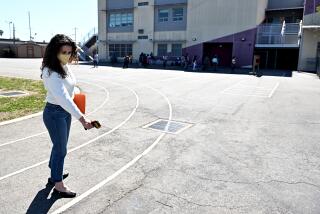La Follette Reopens Issue of Breaking Up L.A. Schools
Assemblywoman Marian W. La Follette (R-Northridge) said Friday that she will introduce legislation next week to study the possibility of breaking up the Los Angeles Unified School District because a majority of registered voters surveyed favors such a plan.
The survey results, La Follette said, proved that there is enough public support for her to move ahead with plans to introduce a bill asking the Legislature to allocate $100,000 for a study of constitutional and economic questions connected with the possible breakup.
According to the poll released by La Follette, more than 50% of a group of voters living within the boundaries of the school district said they were in favor of replacing the elephantine system with several smaller districts.
La Follette said that, if the poll had shown that parents were satisfied with the existing structure of the district, she would not have supported a breakup study.
“This is not an issue that has grown out of my own personal desires,” La Follette told a press conference. “This has grown out of the frustration of parents, teachers and even principals in the district.”
The survey showed that 52% of the 400 respondents were in favor, 17% against and 31% unsure about dividing the district.
The Los Angeles school system is the largest school district in California and second-largest in the nation. The district covers more than 650 square miles, operates 822 schools and special centers, serves 28 cities and employs about 56,000 workers. Its 1987 budget was $3.2 billion.
Breaking up the system into independent districts could provide opportunities for communities to come up with their own answers to issues such as crowding and bilingual education, she said.
But Los Angeles school-board member Jackie Goldberg argued that dismantling the district would create more problems than it would solve.
“Society has changed, and the school districts have not been able to keep up with those changes,” said Goldberg, who represents the Hollywood-Wilshire area. “The system is underfunded,” said Goldberg, and for La Follette “to come up with this when she was part of the machinery that undercut funding is to miss the point and blame the victim.”
La Follette paid $14,000 for the poll, conducted Jan. 19 and 20 by Arnold Steinberg & Associates. Steinberg is a Sherman Oaks political consultant who has worked for many Republican candidates. The money came from political action and campaign committees, she said.
The random sample of voters was selected from each of the seven school-board districts. About 25% of the respondents had school-age children living with them, whereas 43% of those questioned were over 65 and unlikely to have children in school.
Slightly more than 60% of those polled were white. Blacks made up 20% and Latinos 10% of the respondents. Although this reflects the ethnic makeup of registered voters in the district, it clashes with the ethnic makeup of students in district schools.
This fall, Latinos made up 57% of the district’s 592,000 students. Whites accounted for 17%, blacks 18% and Asians 6%.
“If I had my druthers, there would have been more blacks and Hispanics in the survey,” La Follette said, “but the survey was of registered voters. I believe the survey is reflective of community feelings.”
La Follette’s proposal to study dismantling the Los Angeles system will not be the first time the idea has come before the state Legislature. In 1970, the Legislature approved a bill to split up the district, but then-Gov. Ronald Reagan vetoed it, citing the cost of duplicating services.
In 1982, La Follette introduced a bill to separate San Fernando Valley schools from the district, a bill that died in the Assembly Education Committee.
More to Read
Sign up for Essential California
The most important California stories and recommendations in your inbox every morning.
You may occasionally receive promotional content from the Los Angeles Times.










